Top News
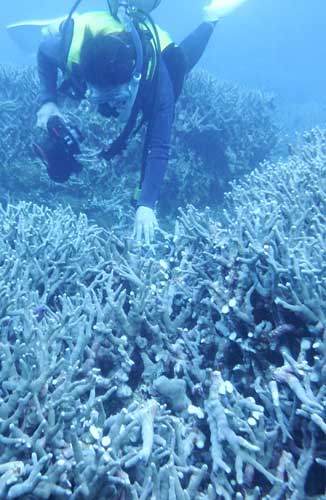
January 13, 2015 Ryukyu Shimpo
A Porites cylindrica coral community in Oura Bay, Nago has been damaged. Members of the Diving Team Rainbow, part of the Helicopter Base Objection Association confirmed this on January 12. The location of the damage is near where a large vessel employed by the Okinawa Defense Bureau anchored to monitor movement of citizens opposing the construction work for replacement of the Futenma Base. A member of the team discovered this on January 10, and another two members confirmed it on January 12.
Members of the diving team alleged, “There is a community of coral reefs beneath the sea where the large vessel anchored. Various size corals have been broken at point-by-point basis. The state and extent of damage to the coral suggests human-caused damage.” The members speculate the ship’s anchor has hurt the coral.
According to the diving team, the coral might have been damaged in two places by the dragging of the anchor. The coral reefs have been broken within an area of about 10 meters in length and 50 centimeters in width, and have been crumbled on a line of about five meters in length in another place. Furthermore, at four or five different locations, the coral reefs have been hurt.
The community of Porites cylindrica stretches off the coast of the Oura district, in a strip shape that is about 100 meters long and 30 meters in width.
The location where the corals have been damaged is outside the temporary restricted area for the relocation work set up by the government.
(English translation by T&CT)
Go to Japanese
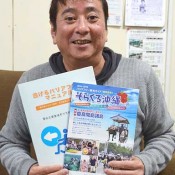
January 6, 2015 Ryukyu Shimpo
On December 25, at the 8th Ministry of Land, Infrastructure, Transport and Tourism Barrier-Free Promotion Awards, non-profit organization “Barrier-Free Network Council” was recognized for operating, among other activities, a tourist information center catering to the physically-impaired and the elderly. This is the second time an Okinawa-based organization has received this award. Delighted, the organization’s director Osamu Oyakawa said, “I am very happy that our efforts have been recognized. We would like to continue helping everyone enjoy Okinawa’s tourist attractions to the fullest.”
The Barrier-Free Network Council was founded in 2002. It operates the first tourist information center specially catering to the physically-impaired and the elderly within a Japanese airport, rents out wheelchairs and other caretaking equipment, and provides information on barrier-free access to tourist attractions in Okinawa.
In 2012, it compiled a “Barrier-Free Evacuation Manual,” which describes evacuation routes and procedures for the mobility-impaired and vulnerable. It also conducted lectures for hotel and attraction staff on proper responses during an emergency.
Director Oyakawa said, “Our activities give people who have disabilities and the elderly the freedom of choice for their vacation. We aim to make tourism in Okinawa truly barrier-free, so anyone can enjoy their trip here.”
(English translation by T&CT and Lima Tokumori)
Go to Japanese
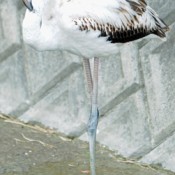
January 11, 2015 Ryukyu Shimpo
Flamingos, which are not normally found in Okinawa, have been spotted on numerous occasions in the central southern part of the island since last December. There are no reports of birds escaping from any facilities in Okinawa. Bird lovers do not have an explanation as to why the bird is in Okinawa.
The bird is confirmed to have been in Okinawa City this year, and was also seen in the central southern part of the island last December.
A flamingo was found at an irrigation canal in Okinawa City on January 10. It put its beak into water to search for food.
In 1999, the Okinawa Zoo and Museum in Okinawa City lost one of two flamingos after a typhoon hit Okinawa. Then the bird was seen at Awase dry beach. The museum does not currently own any flamingos.
(English translation by T&CT)
Go to Japanese
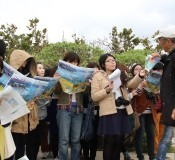
January 8, 2015 Ryukyu Shimpo
On January 8, in front of U.S. Marine Corps Camp Schwab in Henoko, Nago, citizens voiced their protest. They called for the governments of Japan and the United States to cancel the plan to build an offshore U.S. base for replacement of the Futenma base in Ginowan. At 8:00 a.m., five work ships, including a submersible research vehicle, employed by the Okinawa Defense Bureau, left the Teruma Port. Three protest ships were ready on the sea to monitor movement of the work ships.
Meanwhile, about 30 students from four universities, including Tokyo University of Foreign Studies, China and South Korea, visited the Henoko Fishing Port. They listened to a brief on the Henoko issue from Hiroshi Ashitomi, co-representative of the Helicopter Base Objection Association.
A student of SungKongHoe University (Anglican Church University) in Seoul, said, “At the moment when I arrived at Henoko, I thought the situation here is very similar to that in Jeju Island. I want to think about what I can do in Korea.” She took part in the sit-in pretest against the Jeju Naval Base.
(English translation by T&CT)
Go to Japanese
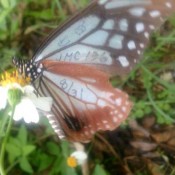
January 7, 2015 Ryota Nakamura of Ryukyu Shimpo
Last November, Yoshiharu Miyagi, administrative director of non-profit organization Yanbarusha, which promotes the connection of Yanbaru’s nature and people, found a Parantica sita, a butterfly from Ishikawa Prefecture. The butterfly had flown from the mainland to a forest in Motobu Town, Okinawa. The butterfly crossed the ocean and traveled 1,350 kilometers. Yanbarusha has worked together with Shioya Elementary School on butterfly observations since 2013. Miyagi says, “I want kids to get more interested.”
On November 1 when Miyagi was driving, he saw a butterfly with different wing patterns. It turned out to be a Parantica sita. A mark on its wing read; “Shirayama JMC 136 8/31.”
A member of Yanbarusha researched online and found out it was a male butterfly marked at Shirayama City in Ishikawa Prefecture on August 31.

Yoshiharu Miyagi
Takeshi Nishimura,the principal of Hokuyo Elementary School in Shirayama City, marked the butterfly. Nishimura has been involved in markings for eight years and also worked prior to that on markings with students of another school.
Parantica sita is known to fly a long distance and had previously been registered as having flown to Okinawa. Nishimura said, “It could be one from further north in Shiryama City. It is impressive such a small butterfly can fly to Okinawa.”
Miyagi started helping Shioya Elementary School’s butterfly observations at Yako, Ogimi Village a couple of years ago. Miyagi showed pictures of the Parantica sita that flew from Ishikawa Prefecture, to school children. They were amazed by it.
Learning that Nishimura, who also observes butterflies with children, made markings, Miyagi said, “This may be fate. It would be nice to have exchange observation meetings with children at Shioya Elementary School.”
(English translation by T&CT and Megumi Chibana)
Go to Japanese
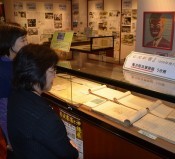
January 7, 2015 Ryukyu Shimpo
On January 7, non-government museum Fukutsukan in Naha, which displays documents relating to the late Okinawan prominent political figure Kamejiro Senaga , started the Iwanami Shoten publisher and Okinawa exhibit.
The exhibition displays a copy of Report from Okinawa which was written by Senaga for Iwanami Paperbacks series, and unpublished manuscripts Senaga wrote for SEKAI, a Japanese monthly journal. The exhibition also shows the journal editors’ letters to Senaga.
Since its launch in 1938, Iwanami Paperbacks has published over 3,000 books. Report from Okinawa is the first book to include the word “Okinawa” in its title. It became a best seller, achieving 124,000 copies.
In the exhibit, six large panels with content looking back on history of Iwanami Shoten publisher, which marked the 100th anniversary of its founding in 2013, were displayed. Visitors can read the company history.
(English translation by T&CT)
Go to Japanese
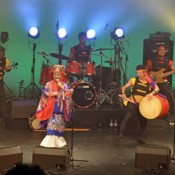
December 29, 2014 Yoko Oshiro, Correspondent of Ryukyu Shimpo
As December arrives and the streets of Paris fill with Parisians in long black coats, the Japan Culture House of Paris sprang to life in vibrant Okinawan colors when Rinken Band held a two-day concert on December 5 and 6.
The performance was held to promote the annual “NiUtu Umachi” music event held in Okinawa City produced by Rinken Band leader Rinken Teruya, and to promote Okinawa Tourism.
Rinken Band was formed in 1977, and their fresh “Okinawan Pop” style of music seemed to be a hit with Parisians.
The concert was filled with spectacles such as a song accompanied with the spirited sounds of Eisa drums. Tomoko Uehara, one of Okinawa’s foremost vocalists, enthralled audiences with her crisp yet powerful and soothing voice.
During the concert’s encore, the audience responded with many enthusiastic calls of “Bravo!” After the encore, a long queue formed as audience members lingered around for the performers’ autographs.
Teruya said, “With this as a stepping stone, we would like to hold more regular concerts in Europe in the future.”
(English translation by T&CT and Lima Tokumori)
Go to Japanese
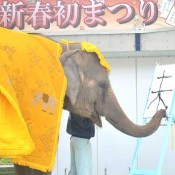
January 3, 2015 Ryukyu Shimpo
On January 2, a New Year’s Festival was held at the Okinawa Zoo & Museum in the Goya district of Okinawa City. Popular Indian elephant Ryuka has performed kakizome, or first calligraphy of the year. She dexterously wrote sheep, this year’s Chinese zodiac sign, in kanji, holding a special customized giant calligraphy brush with her trunk. Visitors to the zoo enjoyed her performance.
The Yonaguni horse, sheep, and goat appeared on stage. The zoo staff transferred a sash to the sheep from the horse, which was last year’s Chinese zodiac animal. A New Year’s Karuta festival was held in the open space of the zoo. Participants played with giant karuta, traditional Japanese playing cards.
Eleven-year-old Yuria Tome who watched Ryuka’s performance, said, “I have experienced writing Japanese Calligraphy. I think it was amazing for Ryuka to be able to write kanji. I would like to make this year happy.”
(English translation by T&CT)
Go to Japanese
December 28, 2014 Ryukyu Shimpo
The U.S. Army in Okinawa will return Gesaji Communication Site, which is located in Gesaji, Higashi, on Feburary 27, 2015. Okinawa Defense Bureau made the announcement on December 25. This communication site is a Long-Range Navigation (LRN) transmitting station. Most of the facility has now been transferred to the 11th Regional Maritime Safety Headquarters of Japan. Only one hectare remains a U.S. military facility. There are no buildings. The defense bureau will carry out an investigation into whether or not the land is contaminated. The land will be returned to the owners by the end of 2015.
(English translation by T&CT, Hitomi Shinzato)
Go to Japanese

January 11, 2015 Ryukyu Shimpo
More than 15 vehicles, including mixer trucks, came into U.S. Marine Corps Camp Schwab from late at night on January 10 until the early hours of the following morning to resume work to build a new U.S. base in Henoko, Nago. The governments of Japan and the United States plan to move U.S. Marine Corps Air Station Futenma to the coastal area in Henoko. In front of the gate of Camp Schwab, about 30 citizens gathered to protest. A man was arrested by Nago Police for alleged assault against a security guard. It is the first time a protester has been arrested at the sit-in, which started in July last year.
According to witnesses, the man hit the face of a security guard with a plastic bottle, when he was restrained by the guard while attempting to sit in front of the gate. The man says, “I believe that I did not hit the face of the security guard [with a bottle], but if he was hit, I would like to apologize to him.”
The mixer trucks and heavy machinery were brought into the base after the citizen group finished their sit-in in front of the gate at 9 p.m. on January 10. At 10 p.m., the citizens gathered again at the scene, receiving an emergency call to block the trucks. The police forcibly removed the protesters.
The citizen group ended their protest action in front of the gate of Schwab, at 3 a.m. on Januray 11. However, they resumed it at 7 a.m. on the same day. About 10 people voiced protest against the construction work.
As of 8 a.m. on January 11, there has been no sign of offshore work in the Henoko coastal area or further arrivals of material and construction vehicles in front of the gate.
(English translation by T&CT)
Go to Japanese
January 8, 2015 Ryukyu Shimpo
We think the administration led by Prime Minister Shinzo Abe does not understand the implications of candidates backed by the ruling Liberal Democratic Party (LDP) being defeated in the Okinawa gubernatorial election and in the Lower House election , in which the LDP lost in all the Okinawan seats.
The Okinawa Prefectural Government (OPG) asked the Minister of Agriculture, Forestry and Fisheries to meet Okinawa Governor Takeshi Onaga who is visiting Tokyo, regarding subsidies for sugarcane production in Okinawa. However, the Ministry of Agriculture, Forestry and Fisheries of Japan refused to do so.
While the ministry stated it could not meet Onaga because of a tight schedule, it met with people involved in the Okinawa branch of the Japan Agricultural Cooperatives accompanied by LDP lawmakers of Okinawa. Normally, when local organizations meet cabinet ministers, local lawmakers of the ruling party acting as go-betweens are accompanied by the governor. But in this case, Onaga was not invited to take part in the meeting. The LDP side shut out Onaga.
It is regretful and problematic that the ministry refused to meet Onaga despite the fact that he represents the Okinawan people as the Okinawan governor.
We assume the ministers curry favor with the Abe administration.
Following his accession to office, Onaga visited Tokyo to meet Abe and Chief Cabinet Secretary Yoshihide Suga at the end of last year. However, they refused to meet the new Okinawan governor. The minister’s subsequent refusal is a continuation of this approach. The Abe administration does not understand that its snub of Onaga has further aggravated Okinawan people’s feeling against the central government. The Japanese government’s refusal to talk with Onaga who won the gubernatorial election by a large margin on a pledge to stop the plan to build a new base to replace Marine Corps Air Station Futenma in Henoko, Nago is equivalent to ignoring hundreds of thousands of Okinawan people’s voices supporting that pledge. The Abe administration is virtually ignoring democracy.
Sources tell us the administration is considering cutting the Okinawa promotion budget for the fiscal 2015. If this is true, the Abe administration is contradicting itself because it has been claiming the base issues are not linked to Okinawa’s funding. The Abe regime appears to be oppressing Okinawa, which opposes its policies.
Furthermore, the LDP headquarters did not invite Onaga to take part in a meeting to discuss the Okinawan promotion budget, which was held on January 8. They are treating the OPG with a totally different attitude than they did the previous one led by former Governor Hirokazu Nakaima, who supported building an alternative base in Henoko.
In the Okinawa branch of the LDP, some members are said to have voiced that they do not need to cooperate with Onaga, who supported anti-LDP candidates in the Okinawan seats in the House of Representatives election. They claim it is reasonable for the lawmakers of the LDP to side with the central government. It appears they are trying to show off their power. However, this attitude of the ruling party members is narrow-minded. Okinawan people are shying away from the LDP lawmakers of Okinawa, who prioritize partisan interests over local interests.
With regard to the central government’s refusal to meet him, Onaga said, “I would like Okinawan people and the people in the main islands of Japan to see the situation as it is, and think about it.” The Abe administration should now directly face the fact that its snub of the Okinawan governor invites further disapproval from Okinawan people and it should be ashamed of its undemocratic attitude.
(English translation by T&CT)
Go to Japanese










 Webcam(Kokusai Street)
Webcam(Kokusai Street)


